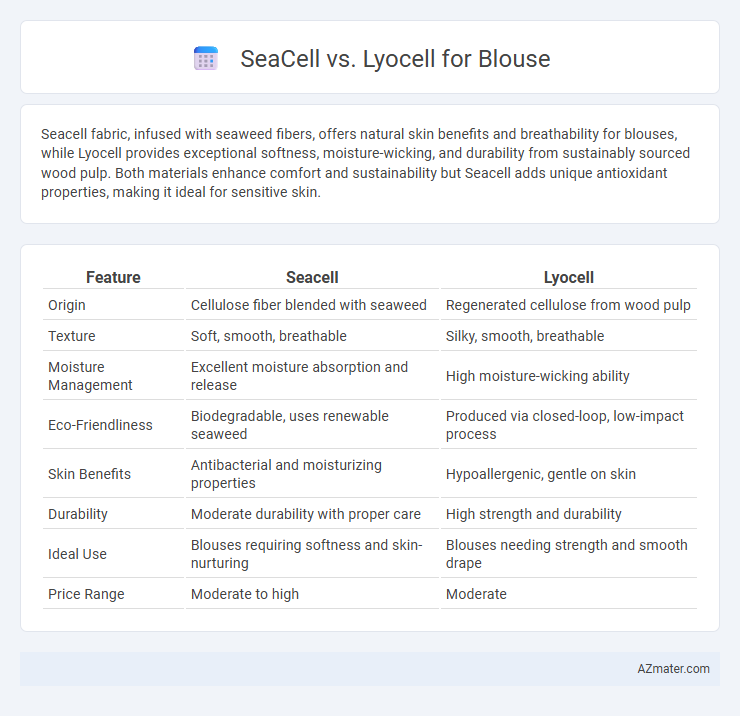Seacell fabric, infused with seaweed fibers, offers natural skin benefits and breathability for blouses, while Lyocell provides exceptional softness, moisture-wicking, and durability from sustainably sourced wood pulp. Both materials enhance comfort and sustainability but Seacell adds unique antioxidant properties, making it ideal for sensitive skin.
Table of Comparison
| Feature | Seacell | Lyocell |
|---|---|---|
| Origin | Cellulose fiber blended with seaweed | Regenerated cellulose from wood pulp |
| Texture | Soft, smooth, breathable | Silky, smooth, breathable |
| Moisture Management | Excellent moisture absorption and release | High moisture-wicking ability |
| Eco-Friendliness | Biodegradable, uses renewable seaweed | Produced via closed-loop, low-impact process |
| Skin Benefits | Antibacterial and moisturizing properties | Hypoallergenic, gentle on skin |
| Durability | Moderate durability with proper care | High strength and durability |
| Ideal Use | Blouses requiring softness and skin-nurturing | Blouses needing strength and smooth drape |
| Price Range | Moderate to high | Moderate |
Introduction: Seacell vs Lyocell for Blouses
Seacell and Lyocell are two innovative fibers used for blouses, each offering unique benefits in comfort and sustainability. Seacell incorporates seaweed extract, providing natural skin-soothing properties and enhanced breathability, ideal for sensitive skin. Lyocell, derived from sustainably sourced wood pulp, boasts excellent moisture-wicking abilities and a smooth, silky texture, making it perfect for lightweight, breathable blouses.
What is Seacell?
Seacell is an innovative fabric made by embedding seaweed extract into TENCEL(tm) Lyocell fibers, combining the softness and breathability of Lyocell with the skin-beneficial properties of seaweed. This blend enhances moisture retention and provides anti-inflammatory benefits, making Seacell an excellent choice for blouses that prioritize comfort and skin health. Lyocell, derived from sustainably sourced wood pulp, is known for its smooth texture and eco-friendly production, but Seacell adds a unique natural vitality and added wellness features to the standard fabric.
What is Lyocell?
Lyocell is a sustainable, biodegradable fiber made from wood pulp, known for its softness, breathability, and moisture-wicking properties, making it ideal for blouses. It offers excellent drape and durability while maintaining a smooth texture that feels gentle against the skin. Compared to Seacell, Lyocell is praised for its eco-friendly closed-loop production process, reducing environmental impact without compromising fabric quality.
Manufacturing Process Comparison
Seacell fabric is produced by embedding seaweed fibers into cellulose fibers, combining marine nutrients with soft, breathable material through a wet-spinning process that preserves bioactive compounds. Lyocell manufacturing involves dissolving wood pulp in a non-toxic solvent via a closed-loop system, enabling an eco-friendly and sustainable production with high fiber strength and moisture absorption. The key difference lies in Seacell's bioactive seaweed integration for skin benefits, while Lyocell emphasizes sustainable, chemical-free fiber regeneration for durability and comfort.
Sustainability and Environmental Impact
Seacell and Lyocell fibers both offer sustainable options for blouses, with Seacell incorporating seaweed, which provides natural bioactive ingredients beneficial for skin and promotes marine ecosystem support. Lyocell, derived from sustainably sourced wood pulp through a closed-loop process, minimizes chemical waste and water usage, making it highly eco-friendly. Both fibers reduce reliance on synthetic materials, contributing to lower environmental footprints in textile production.
Fabric Feel and Comfort
Seacell fabric offers a soft, silky texture infused with seaweed fibers that provide natural moisture-wicking and skin-soothing properties, ideal for comfortable blouse wear. Lyocell, derived from eucalyptus pulp, features a smooth, breathable feel with excellent moisture absorption and durability, ensuring long-lasting comfort throughout the day. Both fabrics excel in softness and breathability, but Seacell emphasizes skin health benefits while Lyocell prioritizes eco-friendly performance and resilience in blouse fabrics.
Moisture-Wicking and Breathability
Seacell fabric, derived from seaweed and cellulose fibers, offers superior moisture-wicking properties by naturally absorbing sweat and releasing it to keep the skin dry, making it ideal for blouses worn in humid conditions. Lyocell, produced from sustainable wood pulp through a closed-loop process, excels in breathability and softness, providing excellent airflow and comfort during extended wear. Both fabrics enhance moisture management, but Seacell's unique seaweed components contribute additional skin-soothing benefits and enhanced moisture regulation compared to Lyocell.
Durability and Care Instructions
Seacell fabric, infused with seaweed fibers, offers natural antibacterial properties but tends to be less durable than Lyocell, which is known for its strength and resistance to wear, making Lyocell a better choice for long-lasting blouses. Seacell requires gentle hand washing or delicate machine cycles in cold water to maintain its integrity, whereas Lyocell is more versatile in care, tolerating machine washing on gentle cycles and air drying to prevent fabric shrinkage and damage. Both fabrics benefit from avoiding high heat in drying and ironing to preserve the blouse's texture and color vibrancy.
Style and Design Versatility
Seacell and Lyocell fibers both offer excellent style and design versatility for blouses, with Seacell providing a natural sheen and subtle texture that enhances elegance and uniqueness. Lyocell's smooth, drapey quality allows for a wide range of fashionable cuts and fluid silhouettes, making it ideal for modern, minimalist designs. Their breathable and soft nature ensures comfort while supporting diverse aesthetic preferences from casual to formal wear.
Which is Better for Blouses?
Seacell fabric, infused with seaweed fibers, offers natural moisture-wicking and skin-soothing properties, making it ideal for blouses worn in warm or sensitive skin conditions. Lyocell, derived from sustainably sourced wood pulp, excels in breathability, softness, and durability, providing a smooth drape and wrinkle resistance perfect for everyday or professional blouses. For blouses, Lyocell generally outperforms Seacell in versatility and comfort, making it the better choice for most wearers seeking both eco-friendliness and long-lasting wear.

Infographic: Seacell vs Lyocell for Blouse
 azmater.com
azmater.com